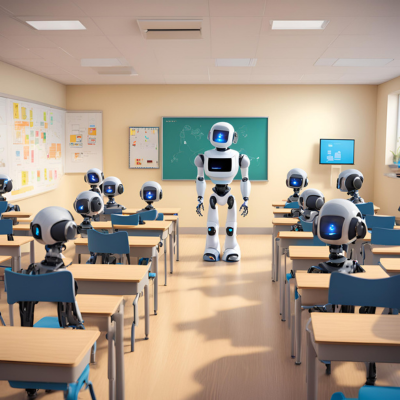EDUCAUSE and Horizon have collaborated for several years to produce a teaching and learning report relating to the effectiveness and implementation of technology. Producing the report requires facilitating discussions with expert panelists.
I am a fan of executive summaries, particularly in lengthy, technical reports. If you don’t have time to read the full report, the Executive Summary provides a decent overview.
The 2024 EDUCAUSE Horizon Report required panelists to provide input across five trend categories: social, technological, economic, environmental, and political (STEEP). Because of the ongoing impact of AI on education, the report’s authors included a list of AI-focused honorary trends.
Social Trends
The authors note that since 2015, public perceptions about higher education and the value of a degree have increased in negativity. With this perception, institutions may face further economic challenges, such as decreased federal and state funding and donor contributions.
Institutional leaders seeking to offset negative public opinion may start efforts to rethink teaching and learning to attract, serve, and keep more students. Expect approaches that include more experiential learning, technology, and real-world applications.
Emphasis on returns on investment may lead to increased emphasis on affordability, equity, and pathways focused on skills-based learning and workforce development. The demographic cliff should increase the number of nontraditional students enrolled in higher education.
Institutions can make their courses more accessible by investing in high-quality online, hybrid, and blended learning options to appeal to nontraditional students. Alternative credentials will also be attractive to working adult students seeking short-term training.
Technological Trends
Colleges and universities must plan for new technologies that enable more adaptive decision-making and more flexible teaching and learning experiences.
Concerns about cybersecurity and privacy are increasing. IT departments will face increased challenges in finding technology that meets security requirements. Increased student concerns about privacy will affect the collection and use of data at colleges and universities.
Researchers expect the education and learning analytics market to grow substantially over the next five years. Learning analytics requires technology and technology infrastructure and people who understand how to collect, analyze, and interpret data literacy initiatives. Universities will also need to comply with student privacy regulations.
Higher education continues to experience a digital divide, primarily in rural areas and low-income and marginalized communities. Students lacking access to technology are falling behind in newer technologies like AI. Limiting the use of digital technology is not a solution, as it will cause lower rates of digital literacy, placing students at a disadvantage.
Economic Trends
Institutions seeking to increase their attractiveness to prospective students are placing more emphasis on workforce development training. Digitization and automation are leading to the elimination of some jobs and the creation of others. Increased demand is expected for upskilling and reskilling workers.

Colleges and universities will need to work with industry partners to develop programs to upskill and re-skill workers. The ability to remain agile and responsive to changing learning needs will be more important than ever. Institutions will need to develop a model to change curriculum quickly enough to meet industry demand.
Employee retention remains an issue for colleges, universities, and non-educational institutions. Millions voluntarily leave their jobs, with Gen Z and millennials the most likely to switch. Higher education staffing issues affect IT, administration, campus services, research, teaching, and the student experience.
Higher education institutions could address workforce retention issues by adapting their programs and approaches to meet the evolving needs of businesses. Working with employers, colleges may create additional incentives, such as tuition discounting, continuing education programs, alternative credentials, and professional development programs.
Student debt is affecting students’ enrollment decisions. Institutions need to move away from a business model that places high costs on students. This model contributes to a student’s low economic power during and after college. The need for colleges to continue to devote time and resources to reducing student debt will increase as the number of diverse and nontraditional students increases.
Environmental Trends
Climate change continues to affect the environment, and institutions have increased their commitment to achieving carbon neutrality by 2050. Sustainability requires resources that may be difficult to get. More colleges are pooling resources from local, regional, and state sources to meet climate, energy efficiency, and economic development goals.
The rapid growth of big data is causing some to be concerned about its environmental impact. Data centers require significant amounts of energy and water. Institutions that collect more data will need to develop plans that adopt new technologies sustainably.
Workforce demands for green skills are increasing, and the demand is outstripping the talent being developed. Institutions will need to increase climate change courses in their curriculum. If they don’t make this training available to all disciplines, the green skills gap could continue to increase. This will leave students unprepared for the workforce.
Political Trends
Political distrust in the U.S. is “driving division in beliefs over what the purpose of college should be, what the college experience should look like, and whether higher education can be trusted.”
People are choosing where to live based on the political climate. This leads faculty and students to live in states with policies that align with their views. Faculty and students relocate based on topics such as gun control, abortion, immigration, DEI, and college entry exam requirements.
Government policy at the federal and state levels is increasingly influencing education. At the state level, legislatures have proposed banning books and certain student political groups. They have also discussed regulating the teaching of sensitive topics surrounding race, gender, and sexuality. Sometimes, these regulations offset new federal regulations.
The report’s authors write that there is considerable uncertainty about what government legislation will be passed. This is especially true with a U.S. presidential election occurring this year.
Regardless of the outcome of the upcoming elections, the report notes that institutions and governments are “likely to continue to focus on major issues such as increasing the value of higher ed to the student and society as a whole, improving higher ed affordability and lowering student debt, and establishing standards that promote student success.”
There is a growing need for policies to address emerging technologies, safeguard users, and promote ethical and responsible usage and outputs. AI is not the only area where many see an increased need for regulation. How quickly these policies and regulations will be developed and implemented, particularly in the U.S., is unknown.
Honorary Trends: Artificial Intelligence
AI is used more and more in human interactions and conversations (Social). Higher education will need to understand the growing ways in which faculty, staff, and students are using AI. It then needs to adapt to changes in the ways students communicate.
AI tools have growing potential to reshape pedagogy and student experiences (Technology). As more and more uses for AI in the classroom emerge, institutions will have to update their guidelines regarding the use of these technologies.

AI is increasingly affecting the economy and the workforce (Economic). AI has the potential to change the way individuals work by boosting productivity. Some worry that the productivity advances could lead to the loss of millions of jobs. Higher ed must change curriculum to prepare students for the changing workforce.
AI is increasingly being used to address climate change and sustainability issues (Environmental). Artificial Intelligence can help detect and monitor climate threats but also combat climate change and increase sustainability. AI-powered technologies should be monitored to reduce emissions and energy consumption on campuses.
The potential for the use of AI in politics is growing (Political). AI is being used by governments to tackle issues. It is also being used to aid political campaigns and elections. Higher ed institutions should prepare to increase their political and information-literacy efforts and develop more curricula about trust.
Key Technologies and Practices
The report describes key technologies and practices that are predicted to significantly affect teaching and learning, considering the STEEP trends identified by the panelists. A recent trend has shifted from identifying discrete technologies toward more holistic practices or approaches to technology use.
Panelists noted two areas specific to mitigating risk: navigating misinformation and protecting data privacy and security. AI tools are making it more difficult to respond to misinformation. Digital security is also critical to ensuring safe and effective use of technology tools.
Finding Appropriate Uses for AI-Enabled Technology
In considering appropriate uses for AI-enabled technologies, the authors provide a list of action considerations:
- Be cautiously optimistic, staying aware of risks and pitfalls.
- Connect with colleagues.
- Consider revising pedagogical elements.
- Think outside the box.
- Use AI-enabled technology to improve human work, not replace it.
Supporting AI Fluency
The report notes that all higher education stakeholders will benefit from learning how to use AI responsibly. Supporting AI fluency is essential for institutions to mitigate AI-related risks. Developments in AI are so rapid that institutions might find their training programs quickly outdated.
In considering ways to support AI fluency, the authors provide a list of action considerations:
- Center ethics, transparency, and accountability.
- Create policy and infrastructure as needed.
- Collaborate with industry partners to understand workforce applications.
- Embrace curiosity.
- Invest in professional development for faculty and staff.
Supporting Fair and Inclusive Learning
This year’s panelists asserted that supporting fair and inclusive learning will become more important than ever as higher ed continues to see changes in student demographics and an increasing digital divide. Large-scale trends are presenting new challenges and risks.
In considering ways to support fair and inclusive learning, the authors provide a list of action considerations:
- Close the digital divide.
- Collaborate, collaborate, collaborate.
- Diversity teaching methods.
- Engage in self-reflection.
- Reduce unnecessary costs.
- Review policies and practices with an equity lens.
- Use inclusive hiring practices.
Protecting Data Privacy and Security
As higher education increases its use of remote modalities for learning and work, data privacy and security will become more consequential. Protecting data privacy and security is a complex task that requires support from multiple groups across a university or college.
In considering ways to increase data privacy and security, the authors provide a list of action steps:
- Foster a culture of data privacy and security across the institution.
- Limit the data collected and stored by your institution.
- Make privacy and security a foundational element for procurement.
- Model good privacy and security practices for students.
- Revise and create policies and guidelines to fit AI use cases.
Navigating Misinformation
“Learning to identify and navigate misinformation is only becoming more challenging due to social media and AI-generated content.” Students need to navigate misinformation to have productive conversations and make informed decisions. Teaching students to navigate misinformation should not impede the freedom of speech.
In considering ways to teach students how to identify and evaluate misinformation, the authors provide a list of action steps:
- Embed instruction about misinformation directly into the curriculum.
- Include instruction about misinformation in institution-wide courses, such as first-year seminars.
- Seek professional development related to digital literacy, including navigating misinformation.
- Stay cognizant of the subjective nature of “truth.”
- Use real-life examples to teach students how to navigate misinformation.
- Work with librarians.
Supporting Mental Health
When the higher education workforce is struggling with burnout, institutions must prioritize mental health. This allows faculty and staff to be happier and more effective employees. Supporting student mental health enables students to bring their best selves to their learning experiences.
In considering ways to support increased mental health services, the authors provide a list of action steps:
- Create a network of layered care for students.
- Incorporate positive mental health practices and resources into the curriculum.
- Promote work-life balance for faculty, staff, and students.
- Remove barriers to attaining accommodations.
- Remove mental health stigma.
- Take good care of your own mental health first.
- Use flexible policies.
The report’s authors and panelists collaborated to imagine how all the elements reported will combine into a series of future scenarios. Four scenarios were created along the following possible futures:
- Growth—Expansion in AI technologies leads to widespread changes to the global workforce across most industries.
- Constraint—The starting point is a future where cybercrime runs rampant.
- Collapse—A world where global division and conflict is increasingly putting pressure on higher ed institutions to “choose sides.”
- Transformation—Institutions are pressed to respond to enrollment challenges exacerbated by declining public perceptions of higher education and the mounting debt crisis.
In this “Cliff Notes” synopsis of the report, I chose not to summarize each scenario. They are worth reading, as is the report in its entirety. The sections of the report and its appendices provide many useful resources.
Final Thoughts
I last reviewed the EDUCAUSE Horizons report in 2022. As I reread that review, I noticed some similarities and a few differences. As you might expect when experts are solicited to be panelists, there were many comments about AI and its ability to affect teaching and learning back in 2022.
As I wrote in my review of the 2022 report, I believed it would be useful as a resource whenever I wrote about specific technologies and how they might affect teaching and learning. The same comment is appropriate this time. However, a reader might have to click the link on a specific resource in the report for more information.
I also published a review of the 2018 Horizon Report in my blog. I asked my provost at APUS, Dr. Vernon Smith, to provide an overview of that report, which he aptly accomplished. Vernon provided some context for the report’s history, our usage at APUS, and at his previous institutions.











